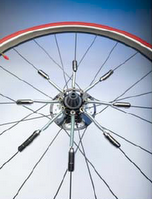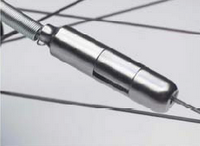Active Spokes
Did you ever see an invention and wonder, “Why didn’t I think of that?” I’ll tell you about my experience with that thought last summer after I was approached by a triathlete from New York who asked me to take a look at his new concept.
It wasn’t the first time someone had asked me to do this. But there had only been one previous invention I thought had any promise. That one was ten years ago and it became the PowerTap™ power meter. It has done pretty well. None of the others I’ve been shown made it to market. They didn’t have any real merit and it was obvious.
So when this triathlete asked me to sign a non-disclosure agreement before seeing his invention I was highly skeptical and was already trying to come up with excuses for why I couldn’t be involved in the project. But when I saw the concept it was like the V-8 commercial where the guy dummy slaps his forehead, only now it was, “I could’ve thought of that!” The concept is quite simple but it contradicts traditional thinking about bicycle wheels. That’s probably the reason no one else, including me, dreamed it up.
The traditional way of viewing race wheels is that they need to be light, especially near the rim, as heavy rims make acceleration more difficult. And since climbing a hill on a bike is essentially a series of alternating decelerations and accelerations with every pedal stroke, we certainly don’t want heavy rims when climbing a hill. Nor do we want heavy rims on a course with a lot of corners. I once did a 30k bike leg in a duathlon that had 36 turns. A heavy rim would have been a disaster for this race with all of the accelerations coming out of each corner.
But there are times when a heavy rim would be advantageous. Nobody ever talks about this, but it’s true. When coming down a hill, starting up the next hill at the bottom of a descent, or riding on a flat course a heavy rim has certain advantages. You’ve probably experienced what I’m describing here if you’ve ever ridden a bike at your gym or health club that has a heavy flywheel. You know how difficult it is to decelerate or stop the thing without using the brake. The wheel just wants to keep on going even without you adding any more energy to the system. If some how your rim could be heavier going down hills and on flat terrain when acceleration is not necessary and light when climbing or coming out of a turn you’d have an advantage. So you have a choice to use either a heavy-rimmed wheel or a light-rimmed wheel when racing. I’ve never known anyone to opt for a heavy race wheel.
We’re pretty much brainwashed by marketing and common practice to believe that a light wheel is the only way to go for all situations. No one goes out and looks for heavy-rimmed wheels when making a purchase. Even if you did decide you wanted to use a heavy rim in a certain race it would require you to buy a second pair of race wheels—if you could find a manufacturer who made an aerodynamic, heavy-rimmed wheel. Good luck.
These thoughts passed through the mind of the inventor I mentioned above during a tough interval training session he was in early last year. His name is Russ Kalil. He's an Ironman. During the session Russ wished he had a heavier rim for the downhills and flats and a lighter one for the uphills and corners. Then it dawned on him—why not make a wheel that changes from a light rim to a heavy rim during the race? So when he got home he went straight to his basement and began toying with the concept he had dreamed up during the workout—a wheel with small weights that move along the spokes back and forth between the hub and the rim. At slow speeds they would be next to the hub. At high speeds they would move to the rim. And when you slow down they’d move back to the hub again. His prototype was made with rubber bands and fishing weights. It worked, at least in his basement on a work bench. So he began to refine it. That’s about when he contacted me.
He wanted to conduct a study to see how it would work in the real world and needed an athlete to test it on. I immediately enlisted my son, Dirk Friel, to be the test subject. Russ also brought Joseph Voelkel, PhD, from the Rochester Institute of Technology, onboard to conduct the testing. So Dirk and Dr. Volekel spent the summer conducting field tests on the 5-mile, rolling course for the Boulder Time Trial Series. What they found was a two- to five-percent improvement in Dirk’s times at a given power with the moving weights compared with the same wheel without the weights. In fact, Dirk went on to have his fastest time ever in one of the races in the series using the invention, which is now called the Active Spoke™.
Now as a much more refined and elegant device Russ has figured out how to calibrate the weights so they move to the rim at a specified speed. So you can customize the wheel to your typical race speeds and the course you’ll be racing on. The device can be installed on your existing race wheels (see photos). Look for a manufacturer’s wheel with this technology built in to also be available soon.

The bottom line is that the concept works. You’ll race faster on certain courses using Active Spokes™. When you see the simple concept in action you’ll probably do the same dummy slap I did and wonder why you didn’t think of it.

